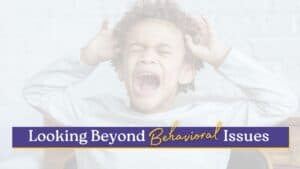
Looking Beyond Behavioral Issues
Behavioral issues can be incredibly consuming and overwhelming, to say the least! In working with families, I always remind parents that they are not alone in facing these difficulties. These

Understanding nonverbal cues is crucial for supporting children, especially those who have experienced trauma.
Twelve-year-old Liam is a pouter. He comes to the after-school program because his single mother works late, and no one else is home to watch him. When Liam pouts, the volunteers ignore. But if they understood nonverbal vocabulary, they might approach him differently.
Much of what we communicate is nonverbal. A child’s body language and facial expressions convey countless feelings. To care well for children and teens who have experienced trauma, we need to understand the power of body language and the message behind the behavior.
Child-development expert Dr. Karyn Purvis said, “Behavior is the language of children who have lost their voice.” As a counselor and trauma-care trainer, I’ve observed that children who have been through trauma or have come from “hard places” often learn to keep silent. They’ve discovered from past experience that it does no good to express needs, so they act out instead. Many children learn early on to mask their feelings—usually fear—and adapt their behaviors to their circumstances. Life has taught them three survival rules: Don’t talk, don’t trust and don’t feel. The fight, flight or freeze response becomes their go-to coping mechanism. Learning our children’s behavioral language is essential to help them heal from trauma.
When a child is acting up, it can be easy to get caught in what’s known as a negative-reaction cycle. Let’s say your child is hungry, tired, frustrated or experiencing sensory overload but expresses this with bad behavior. You immediately react to the behavior with a disciplinary measure, which results in more bad behavior and another negative-reaction cycle repeats itself.
Children need safe adults to help them connect and communicate when they misbehave. But instead of connecting, we may unwittingly disconnect from our children during behavioral episodes.
We do this by:
• isolating them in their rooms
• using harsh disciplinary language
• applying physical discipline
Our children need to know we’re fully present and we enjoy being with them. Here are a few ways to connect with your child before you correct behavior:
Getting down to your child’s level and making eye contact communicates, “I see you.” Pause what you’re doing and look at your child instead of the behavior. Once you establish eye contact, gently redirect the negative behavior.
An orphanage caregiver in Mexico told me, “While caring full time for 10 boys in a children’s home, I often encountered a lot of resistance at bedtime. One night, a boy refused to get in bed. He sat on the couch in silence—unmovable. Once the rest of the kids were in bed, I sat next to him and said, ‘It looks like Antonio is frozen. He’s probably a Popsicle. I wonder what flavor he is. I sure hope he isn’t grape.’ His frozen demeanor finally cracked, and he said, ‘I’m grape.’ ”
It was just the opening the caregiver needed to reconnect with Antonio before correcting his behavior.
Children need to know they’re seen and heard. Leading with empathy and understanding can help establish a connection and a foundation for effective correction. If your child says, “I don’t want to come inside!” connect first by saying, “I understand,” “I hear you” or “I know it’s more fun to play outside.”
Build a safe place to open up and share by acknowledging your child’s feelings and asking meaningful questions to better understand your child’s perspective.
To help your child verbalize needs or feelings instead of acting out, you might say in a reassuring tone, “Use your words, not your behavior. What do you need?” You may need to repeat this phrase until it becomes second nature for your child.
Your presence, along with a gentle touch on a hand or shoulder, fosters connection and conveys to your child, “I’m here. No matter what, I want to be with you.”
There is almost always a deeper meaning behind a child’s behavior. Learning to read your child’s body language and connect before correcting behavior takes practice, but it will open the door for a stronger relationship.